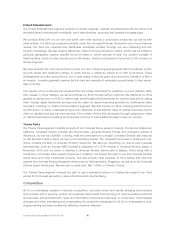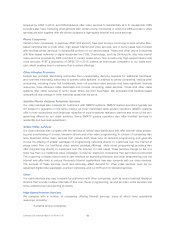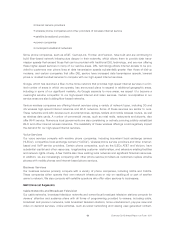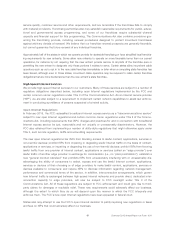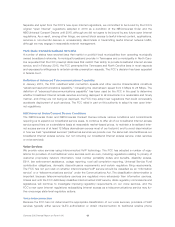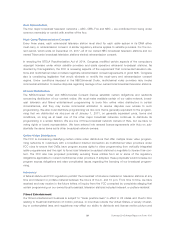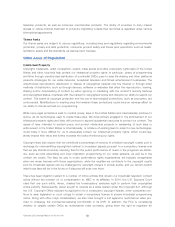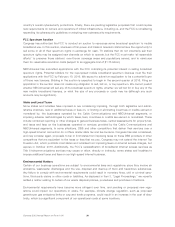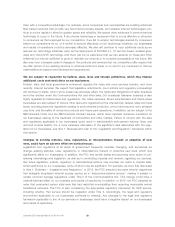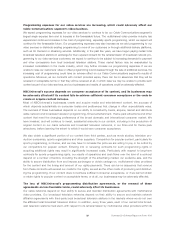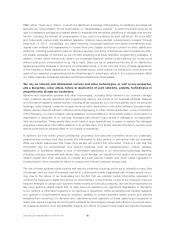Comcast 2015 Annual Report Download - page 23
Download and view the complete annual report
Please find page 23 of the 2015 Comcast annual report below. You can navigate through the pages in the report by either clicking on the pages listed below, or by using the keyword search tool below to find specific information within the annual report.Children’s Programming
Under federal regulations, the amount of commercial content that may be shown on cable networks, broad-
cast networks and broadcast television stations during programming originally produced and broadcast
primarily for an audience of children under 13 years of age is limited, and certain television station program-
ming must serve the educational and informational needs of children under 17 years of age. In addition, the
NBCUniversal Order includes certain commitments and conditions related to children’s television and advertis-
ing directed at children.
Broadcast Television
Licensing
Local broadcast television stations may be operated only in accordance with a license issued by the FCC
upon a finding that the grant of the license will serve the public interest, convenience and necessity. The FCC
grants broadcast television station licenses for specific periods of time, which may be renewed with or with-
out conditions. Substantially all of our broadcast television station licenses have pending applications for
renewal, although our stations’ authority to operate is automatically extended while a renewal application is
under review. Several of these applications have been opposed by third parties, and other applications are
pending. Although our licenses have been renewed in the past, there can be no assurance that we will always
obtain them.
Ownership Limits
FCC regulations limit the ability of individuals and entities to have “attributable interests” above specific owner-
ship levels in local television stations and place limitations on ownership of other specified mass media
entities, such as limits on the cross-ownership of broadcast stations and newspapers in the same market.
The FCC is reviewing the ownership regulations detailed below in 2016.
Local Television Ownership
Under FCC regulations, a licensee generally may own up to two broadcast television stations in the same
DMA, as long as at least one of the stations is not among the top four-ranked stations in the market based
on audience share and there are at least eight independently owned and operating full-power broadcast tele-
vision stations in the market. Without regard to the number of remaining independently owned television
stations, ownership of more than one television station within the same DMA is permitted so long as certain
signal contours of the stations involved do not overlap.
National Television Ownership
The Communications Act and FCC regulations limit the number of broadcast television stations one entity
may own or control nationally. No entity may have an attributable interest in broadcast television stations that
reach, in the aggregate, more than 39% of all U.S. television households. Our owned television station reach
does not exceed this limit. The FCC is considering eliminating a rule that currently affords UHF stations
(channels 14 and above) a 50% discount in calculating the extent of an individual station owner’s holdings
under the national cap, which if adopted, would place us closer to the national cap and limit our flexibility to
acquire stations in the future.
Foreign Ownership
The Communications Act generally limits foreign ownership in a broadcast station to 20% direct ownership
and 25% indirect ownership, although the limit on indirect ownership can be waived if the FCC finds it to be
in the public interest. For many decades the FCC declined to waive the 25% indirect limit in broadcast trans-
actions, but since 2013, it has been willing to consider such waiver requests.
Comcast 2015 Annual Report on Form 10-K 20


